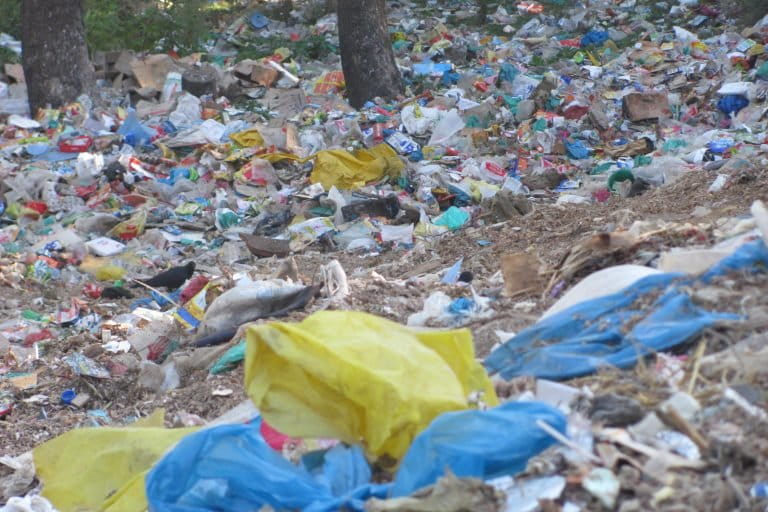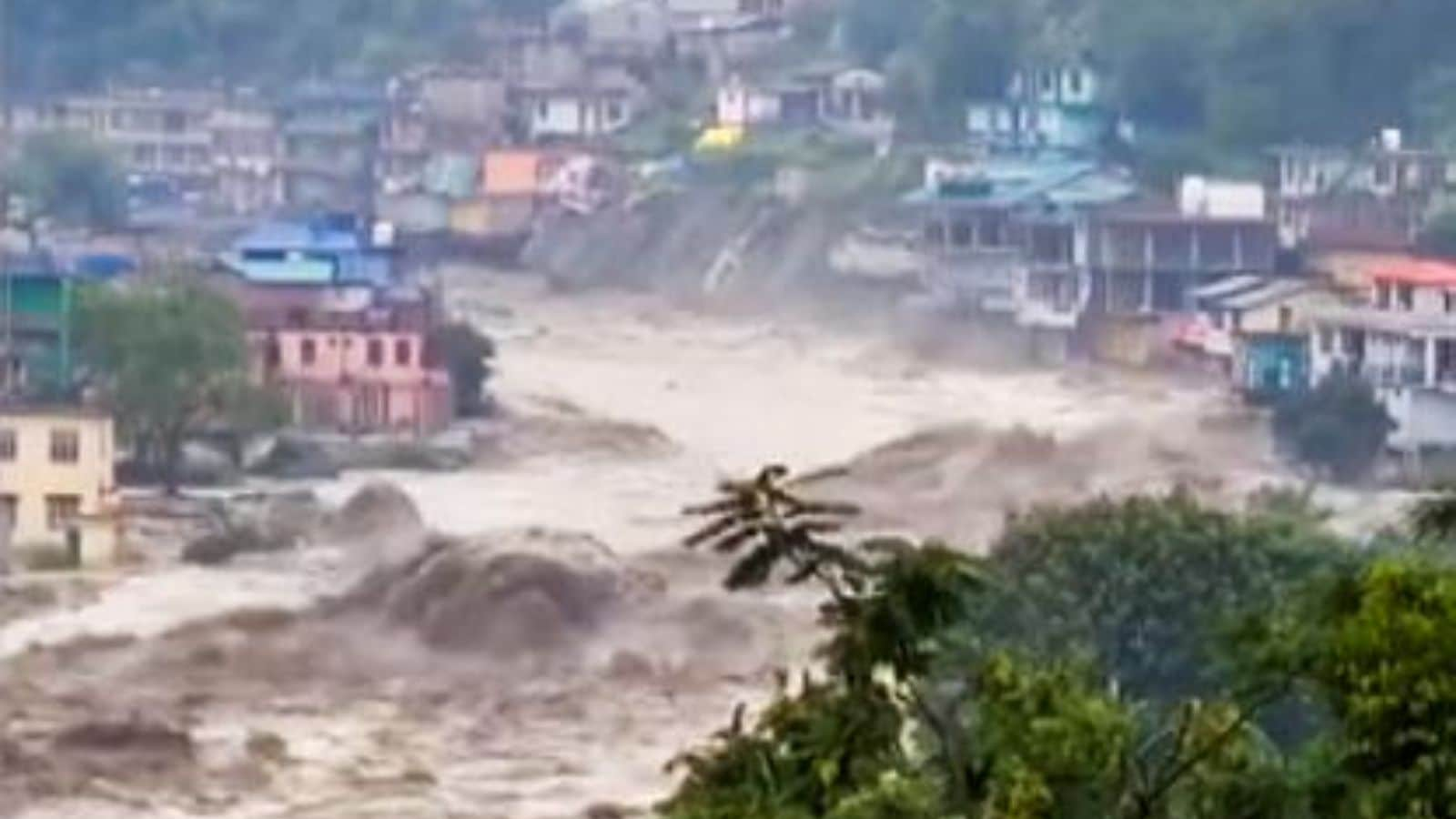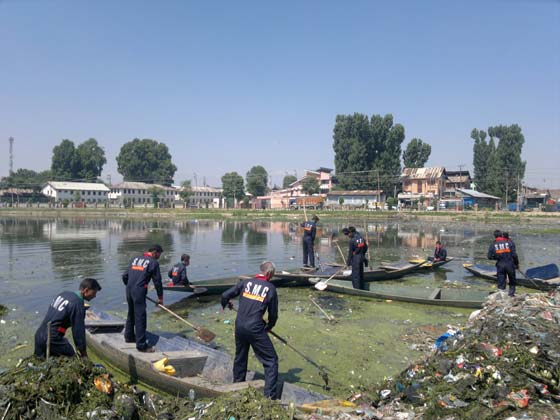Unregulated Tourism Threatens Rivers in Pahalgam | Environmental Crisis in Kashmir’s Tourism Belt
By: Javid Amin | 10 October 2025
Paradise Under Pressure
For decades, Pahalgam has been described in postcards, travel brochures, and songs as “Heaven on Earth.” With its snow-kissed peaks, pine-covered slopes, and the crystal-clear Lidder River, this small town in South Kashmir has enchanted millions of travelers. It is also one of the key gateway points to the revered Amarnath Cave Temple, making it both a tourist hotspot and a spiritual destination.
But behind this postcard-perfect image lies a disturbing truth.
A paradise is being slowly poisoned—not by war or politics—but by unchecked tourism, poor waste management, and government inaction. What was once a pristine mountain river is now burdened with plastic waste, untreated sewage, and the scars of haphazard construction.
“Tourism is our lifeline,” says Ghulam Nabi, a 52-year-old shopkeeper who grew up on the banks of the Lidder. “But it’s also becoming the reason why the river is dying.”
Pahalgam’s environmental degradation is not just a local issue—it is a case study in how fragile ecosystems collapse when economic growth is prioritized over ecological balance.
The Lidder River: A Jewel Losing Its Shine
The Lidder River originates from the Kolhoi Glacier in the Anantnag district of Jammu and Kashmir. Flowing for about 73 kilometers, it is one of the most important tributaries of the Jhelum River. Its turquoise waters nourish fields, sustain forests, and quench the thirst of thousands of residents along its course.
For centuries, the Lidder has been:
-
A source of drinking water for Pahalgam and surrounding villages.
-
A hub for trout fishing, contributing to the local economy.
-
A lifeline for tourism, with rafting, camping, and picnics attracting visitors.
-
An ecological artery for wildlife and alpine vegetation.
But over the last two decades, the river has begun showing signs of distress.
Warning Signs Emerging
-
Discolored water: Locals report that the once crystal-clear water now turns murky, especially during peak tourist months (May–August).
-
Declining trout populations: Anglers have noticed a significant drop in fish sightings, an indicator of reduced oxygen levels and water contamination.
-
Erosion and encroachment: Construction close to the riverbank has destabilized soil, accelerating erosion.
-
Plastic accumulation: From polythene bags to single-use water bottles, the banks are littered with waste.
Scientific Backing
A 2023 study by local ecologists revealed a 37% decline in water quality index of Lidder River over the past 10 years. Levels of coliform bacteria have crossed safe limits in several stretches, making the water unsafe for direct consumption.
“We are witnessing a slow but certain ecological collapse,” explains Dr. Meher Fatima, an ecologist based in Srinagar. “What’s alarming is the speed at which degradation is happening.”
A Brief History of Pahalgam’s Eco-Identity
Before it became a bustling tourist hub, Pahalgam was a quiet pastoral settlement. Shepherd communities, particularly the Gujjars and Bakarwals, would move through the meadows during seasonal migrations. The Lidder River was not just a water source—it was a part of their cultural fabric.
In the 1960s and 70s, when tourism in Kashmir began to flourish, Pahalgam emerged as a scenic summer retreat for travelers. Wooden huts, a few guesthouses, and traditional shikaras defined the landscape.
By the late 1990s and early 2000s, however, the tourism boom brought rapid commercialization:
-
Roads widened to accommodate tour buses.
-
Hotels mushroomed without proper waste treatment systems.
-
Shops and restaurants multiplied, but waste disposal mechanisms didn’t keep pace.
-
Natural meadows and riverbanks were converted into parking lots and commercial strips.
Today, more than a million tourists visit Pahalgam every year. But the town’s ecological carrying capacity is nowhere near that number.
Unregulated Tourism and Its Invisible Costs
Tourism is often celebrated as an economic savior for mountain communities. But when tourism outpaces local infrastructure, the consequences can be devastating.
Tourist Influx in Numbers
According to the Tourism Department, Pahalgam received:
-
1.2 million tourists in 2023
-
Peak season footfall: May–August
-
Pilgrim traffic during Amarnath Yatra accounts for nearly 25–30% of visitors
Every tourist generates approximately 0.5 to 1.5 kg of solid waste daily. Multiply that by over a million, and the numbers speak for themselves.
Invisible Environmental Costs
-
Solid Waste Accumulation: Plastic bottles, food wrappers, and single-use packaging find their way into the river and surrounding forests.
-
Sewage Overload: With no centralized sewage treatment plant, most guesthouses discharge waste directly into the water.
-
Pressure on Water Resources: Tourists consume nearly double the water of local residents, draining natural springs and increasing dependency on the Lidder.
-
Wildlife Disturbance: Noise pollution and crowding disrupt the behavior of local fauna like the Himalayan brown bear and migratory birds.
“Tourism gives jobs, but it also brings garbage,” says Shazia Begum, a school teacher in Pahalgam. “Our children can no longer play near the river as we once did.”
Carrying Capacity Overrun
Experts estimate that Pahalgam’s carrying capacity—the number of tourists it can host without damaging the environment—is around 300,000–400,000 visitors annually. Current figures are more than triple that number.
Rivers Under Siege: Ground Reality of Pollution
On a recent ground visit during the monsoon, the banks of the Lidder River revealed a heartbreaking sight: mounds of plastic, construction debris, and sewage outflows trickling into the stream.
Sources of Pollution
-
Plastic and Solid Waste
-
Tourists often leave behind bottles, wrappers, disposable cutlery.
-
Waste bins are either insufficient or overflowing.
-
-
Sewage Discharge
-
Majority of guesthouses use septic tanks that often leak.
-
Hotels without treatment plants discharge directly into the river.
-
-
Construction Waste
-
Riverbanks have become dumping grounds for sand, gravel, and broken bricks.
-
Erosion worsens with every illegal structure.
-
-
Pilgrim Footfall
-
Temporary camps during Amarnath Yatra generate huge amounts of untreated waste.
-
Impact on River Health
-
Increased Biological Oxygen Demand (BOD), which suffocates aquatic life.
-
Rise in E. coli levels, posing health risks to locals and visitors.
-
Siltation and narrowing of river channels, increasing flood risk.
-
Depletion of trout breeding grounds, threatening livelihoods.
“If you visit upstream Kolhoi, the water is clear. But by the time it reaches the main Pahalgam market, it’s almost unrecognizable,” says engineer Basharat Ahmad from the local waterworks department.
Construction Boom: Concrete vs. Ecology
The town of Pahalgam has witnessed an unprecedented construction boom over the last 15 years. From luxury resorts to budget lodges, buildings have mushroomed along the riverfront—many without environmental clearance.
Violation of Buffer Zone Norms
Environmental guidelines require a minimum 50-meter buffer zone along major water bodies where no permanent construction is allowed. In Pahalgam:
-
Several hotels are built within 10–15 meters of the riverbank.
-
Encroachments have narrowed the natural floodplain.
-
Erosion control measures are minimal or absent.
Unregulated Real Estate
-
A large portion of construction is unplanned or illegal, bypassing environmental clearances.
-
Natural drainage channels have been blocked, leading to waterlogging and landslides.
Ecological Consequences
-
Erosion: Heavy structures destabilize soft riverbanks.
-
Sedimentation: Construction debris seeps into the riverbed.
-
Flood Risk: The Lidder’s capacity to absorb monsoon overflow has been reduced.
“We’re building on the river’s lungs,” warns civil engineer Irfan Lone. “This is not development—it’s ecological suicide.”
Policy Paralysis and Governance Gaps
Despite multiple reports and environmental assessments, government action has been largely symbolic. Bureaucratic red tape and political indecision have allowed the situation to deteriorate.
Missed Opportunities
-
Environmental Impact Assessments (EIAs) conducted since 2010 have repeatedly flagged the same issues: illegal construction, lack of sewage treatment, and solid waste mismanagement.
-
Implementation remains patchy or non-existent.
Fragmented Responsibility
-
Multiple departments—Tourism, Pahalgam Development Authority, Pollution Control Board, Forest Department—operate with poor coordination.
-
No single agency is held accountable for river health.
Regulatory Loopholes
-
Hotels and guesthouses operate without proper environmental clearances.
-
Pilgrim camps often get temporary exemptions, leading to unchecked waste.
“It’s not that we don’t have policies,” says environmental lawyer Shabir Ahmad. “It’s that we don’t enforce them.”
Voices from the Ground: Local Perspectives
Pahalgam’s environmental crisis is deeply personal for its residents. It affects their health, economy, and cultural identity.
Shopkeepers and Small Business Owners
Ghulam Nabi, who owns a souvenir shop, says:
“I’ve seen this town change. Earlier, the river was our pride. Now, we hide it from tourists because it smells.”
Fisherfolk and Farmers
For families who depend on trout fishing:
“We catch less fish each year,” says Abdul Rashid, a fisherman. “Polluted water means fewer fish and less income.”
Youth and Students
Young environmental volunteers express frustration:
“We clean the riverbanks every month, but what’s the use if hotels keep dumping waste?” asks 19-year-old Aaliya Mir, part of a local youth group.
Their stories underline a painful truth: economic gain is coming at the cost of their ecological future.
The Role of Tourism Operators and Visitors
Tour operators, hoteliers, and tourists themselves are not just passive bystanders—they are active participants in this crisis.
Tourism Operators
-
Many small hotels lack proper waste disposal systems.
-
Tour packages seldom include environmental education.
-
There is minimal incentive for sustainable practices.
Tourists
-
Littering is rampant, with little fear of penalties.
-
Lack of eco-awareness leads to careless behavior like washing vehicles in the river or leaving behind single-use plastic.
A Shared Responsibility
Sustainable tourism can only succeed if all stakeholders—government, businesses, and visitors—play their part.
“Tourists love to click pictures with the river. But they don’t see how their waste ends up in it,” remarks local rafting guide Mushtaq Dar.
Climate Change and Himalayan Fragility
The Himalayas are among the most climate-sensitive regions in the world. Changes in temperature, rainfall, and glacial melt are already altering river flows and increasing vulnerability.
Climate Impacts on Lidder River
-
Glacial retreat at Kolhoi means reduced summer flow over time.
-
Unpredictable rainfall causes flash floods that worsen erosion.
-
Warmer temperatures affect aquatic ecosystems and trout breeding.
Compounded Risk
Pollution and construction amplify these natural threats. A degraded river has less resilience against climate shocks.
“Climate change is the background music to this entire story,” explains Dr. Fatima. “And right now, it’s playing louder than ever.”
Grassroots Movements Lighting the Way
Amid the crisis, grassroots groups are emerging as the unsung heroes of Pahalgam’s environmental fight.
Clean Lidder Campaign
Launched by local youth in 2019, this movement organizes:
-
Riverbank cleanup drives every weekend.
-
Plastic-free tourism awareness campaigns.
-
Workshops for hotel owners on sustainable practices.
Eco-Pahalgam Initiative
Supported by local NGOs and some private lodges:
-
Advocates for eco-tourism models.
-
Promotes waste segregation at source.
-
Engages tourists through volunteer tourism programs.
Community Ownership
Unlike top-down policies, these initiatives involve the community directly, creating a sense of ownership over natural resources.
“We can’t wait for the government to act. This is our home,” says Aaliya Mir.
Learning from Global Eco-Tourism Models
Pahalgam is not the first destination to face the dark side of mass tourism. Around the world, fragile ecosystems have been protected through smart, people-centered eco-tourism models.
Case Study 1: Bhutan
-
Strict tourist caps
-
High-value, low-impact tourism model
-
Revenue used for conservation
Case Study 2: Bali, Indonesia
-
Community-based waste management systems
-
Eco-certifications for hotels
-
Strong local tourism councils
Case Study 3: Switzerland
-
No construction near critical water bodies
-
Advanced sewage treatment
-
Eco-taxes that fund conservation
These models show that tourism and environmental protection can coexist, but only with clear vision, regulation, and accountability.
Sustainable Solutions: What Needs to Change
Experts and environmental groups agree on several urgent and practical measures to reverse Pahalgam’s decline:
1. Strict Construction Norms
-
Enforce a no-build buffer zone of at least 50 meters from riverbanks.
-
Demolish illegal structures and rehabilitate affected areas.
2. Waste Management Infrastructure
-
Install segregated waste bins across town.
-
Establish waste collection and recycling units.
-
Ban single-use plastic in core areas.
3. Sewage Treatment
-
Build a centralized sewage treatment plant.
-
Make it mandatory for hotels to connect to the system.
4. Tourist Regulation
-
Cap daily tourist numbers during peak seasons.
-
Introduce eco-tourism entry fees to fund conservation.
-
Launch visitor education programs on responsible travel.
5. Policy and Governance
-
Create a River Protection Task Force with real enforcement powers.
-
Coordinate between departments with a single accountability mechanism.
6. Community Empowerment
-
Involve locals in decision-making.
-
Support community-led eco-businesses.
A Roadmap for the Future
Restoring the Lidder River and preserving Pahalgam is not an impossible dream. It requires political will, scientific planning, and public participation.
Short-Term Goals (1–2 years):
-
Ban on new construction within buffer zones
-
Launch of a pilot waste segregation and recycling program
-
Strict enforcement during pilgrimage seasons
Medium-Term Goals (3–5 years):
-
Establishment of a modern sewage treatment plant
-
Comprehensive riverbank restoration
-
Regulated tourist entry system
Long-Term Goals (5–10 years):
-
Integration of Pahalgam into a UNESCO eco-tourism model
-
Climate adaptation strategies for glacial-fed rivers
-
A self-sustaining, community-led conservation economy
“If we act now, we can save the river,” says Dr. Fatima. “But if we delay, paradise may be lost forever.”
Final Word: Saving Paradise Before It’s Lost
Pahalgam is more than a tourist destination. It is a living, breathing ecosystem that has sustained generations. Its rivers are not just water—they are culture, identity, and life itself.
The story of Lidder River is a mirror to countless mountain destinations around the world. When tourism grows without environmental wisdom, nature pays the price.
But this is also a story of hope. The same community that has witnessed the river’s decline is rising to defend it. If governments, businesses, and travelers rally together, Pahalgam can once again become the paradise it was meant to be—not just in postcards, but in reality.
Quick Facts at a Glance
-
Location: Pahalgam, South Kashmir
-
River: Lidder River, tributary of Jhelum
-
Tourists per year: 1.2 million (2023)
-
Main pollution sources: Plastic waste, sewage, construction debris
-
Buffer zone violation: Constructions as close as 10 meters
-
Grassroots initiatives: Clean Lidder Campaign, Eco-Pahalgam



